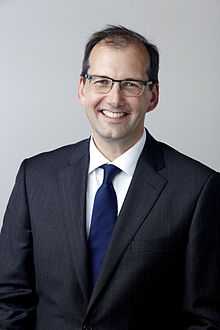Paul Midgley
| Paul Midgley | |
|---|---|
 Paul Midgley in 2014, portrait via the Royal Society | |
| Born |
Paul Anthony Midgley 22 March 1966[1] Welwyn Garden City[1] |
| Fields | |
| Institutions | |
| Alma mater | University of Bristol (BSc, MSc, PhD) |
| Thesis | Electron microscopy of high Tc superconductors and related oxides (1991) |
| Doctoral students | Joanne Sharp[2] |
| Notable awards |
|
|
Website www-hrem | |
Paul Anthony Midgley (born 1966)[1] FRS is a Professor of Materials Science in the Department of Materials Science and Metallurgy at the University of Cambridge[4][5] and a fellow of Peterhouse, Cambridge.
Education
Midgley was educated at the University of Bristol where he was awarded a Master of Science degree in 1988[6] and a PhD in 1991[7] for work on electron microscopy of high-temperature superconductors.
Career
Before moving to Cambridge in 1997, Midgley held two postdoctoral research fellowships in the Henry Herbert Wills Physics Laboratory at the University of Bristol.
Research
Midgley's research interests are in electron tomography, electron holography, energy-filtered imaging and ab initio structure determination by electron diffraction.[8][9][10][11][12] During his research, Midgley has collaborated with Mark Welland,[13] Rafal Dunin-Borkowski,[14] Neil Mathur,[15] John Meurig Thomas,[16][17] Brian F. G. Johnson[16] and Henning Sirringhaus.[18]
Midgley's research has been funded by the Engineering and Physical Sciences Research Council (EPSRC),[19] the Royal Commission for the Exhibition of 1851 and the Royal Society.[8]
Awards and honours
Midgley was elected a Fellow of the Royal Society (FRS) in 2014. His nomination reads:
| “ | Midgley is distinguished for many innovations and impressive applications of transmission microscopy, diffraction and spectroscopy, particularly the pioneering development of sub-nanometre-scale electron tomography. His combination of high-angle dark field tomography and spectroscopy revolutionises the 3-d characterisation of materials and heterogeneous catalysts. He has successfully mapped dislocation networks with diffraction contrast tomography. With his world leading position in medium resolution electron holography, he has been able to combine this with tomography in 3-d mapping of electric fields and dopant distributions in semiconductor devices. His brilliant applications of electron diffraction to sub-micron structures, heavy fermion systems and mixed-valent manganites were important breakthroughs.[3] | ” |
References
- ↑ 1.0 1.1 1.2 MIDGLEY, Prof. Paul Anthony. Who's Who 2015 (online Oxford University Press ed.). A & C Black, an imprint of Bloomsbury Publishing plc. (subscription required)
- ↑ Sharp, Joanne (2010). Electron tomography of defects (PhD thesis). University of Cambridge.
- ↑ 3.0 3.1 "Professor Paul Midgley FRS". London: The Royal Society. Archived from the original on 2014-11-06.
- ↑ List of publications from Microsoft Academic Search
- ↑ Paul Midgley's publications indexed by the Scopus bibliographic database, a service provided by Elsevier.
- ↑ Midgley, Paul Anthony (1988). Characterisation of Bi-Sr-Ca-Cu-O superconductor (MSc thesis). University of Bristol.
- ↑ Midgley, Paul Anthony (1991). Electron microscopy of high Tc superconductors and related oxides (PhD thesis). University of Bristol.
- ↑ 8.0 8.1 Professor Paul A. Midgley, University of Cambridge
- ↑ Midgley, P. A.; Weyland, M. (2003). "3D electron microscopy in the physical sciences: The development of Z-contrast and EFTEM tomography". Ultramicroscopy 96 (3–4): 413. doi:10.1016/S0304-3991(03)00105-0.
- ↑ Vincent, R.; Midgley, P. A. (1994). "Double conical beam-rocking system for measurement of integrated electron diffraction intensities". Ultramicroscopy 53 (3): 271. doi:10.1016/0304-3991(94)90039-6.
- ↑ Gamarra, D.; Munuera, G.; Hungria, A. B.; Fernandez-Garcia, M.; Conesa, J. C.; Midgley, P. A.; Wang, X. Q.; Hanson, J. C.; Rodriguez, J. A.; Martinez-Arias, A. (2007). "Structure-Activity Relationship in Nanostructured Copper-Ceria-Based Preferential CO Oxidation Catalysts". Journal of Physical Chemistry C 111 (29): 11026. doi:10.1021/jp072243k.
- ↑ Midgley, P. A.; Ward, E. P. W.; Hungría, A. B.; Thomas, J. M. (2007). "Nanotomography in the chemical, biological and materials sciences". Chemical Society Reviews 36 (9): 1477. doi:10.1039/b701569k.
- ↑ Porter, A. E.; Gass, M.; Muller, K.; Skepper, J. N.; Midgley, P. A.; Welland, M. (2007). "Direct imaging of single-walled carbon nanotubes in cells". Nature Nanotechnology 2 (11): 713–7. doi:10.1038/nnano.2007.347. PMID 18654411.
- ↑ Midgley, P. A.; Dunin-Borkowski, R. E. (2009). "Electron tomography and holography in materials science". Nature Materials 8 (4): 271. doi:10.1038/nmat2406.
- ↑ Loudon, J. C.; Mathur, N. D.; Midgley, P. A. (2002). "Charge-ordered ferromagnetic phase in La0.5Ca0.5MnO3". Nature 420 (6917): 797. doi:10.1038/nature01299.
- ↑ 16.0 16.1 Midgley, P. A.; Weyland, M.; Thomas, J. M.; Johnson, B. F. G. (2001). "Z-Contrast tomography: A technique in three-dimensional nanostructural analysis based on Rutherford scattering". Chemical Communications (10): 907. doi:10.1039/B101819C.
- ↑ Thomas, J. M.; Johnson, B. F. G.; Raja, R.; Sankar, G.; Midgley, P. A. (2003). "High-Performance Nanocatalysts for Single-Step Hydrogenations". Accounts of Chemical Research 36: 20. doi:10.1021/ar990017q.
- ↑ Eggeman, A. S.; Illig, S.; Troisi, A.; Sirringhaus, H.; Midgley, P. A. (2013). "Measurement of molecular motion in organic semiconductors by thermal diffuse electron scattering". Nature Materials 12 (11): 1045. doi:10.1038/nmat3710.
- ↑ UK Government research grants awarded to Paul Midgley, via Research Councils UK
|